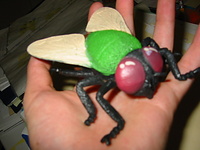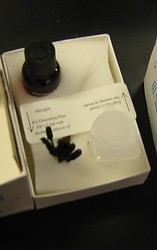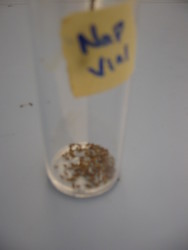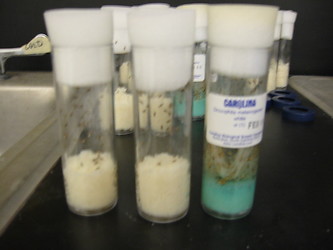Introduction
This experiment is to study and test the life cycles of different Drosophila, or the common fruit fly. We had to cross-breed. For our fruit fly experiment, we crossed wild type with mutant white eye.
Kingdom: Animalia
Phylum: Arthropoda
Class: Insecta
Order: Diptera
Family: Drosophilidea
Phenotypes
Red Eyes-wild type(+), Recessive sex-linked white eye(w) & vestigial(vg)
White Eye (w) x Wild Type (+)
| + | + | |
| w | w+ | w+ |
| w | w+ | w+ |
We predicted 100% heterozygous wild eye.
Observation Log
- 2/27: Flies expanded to new cultures
- 3/02: No sing of larva *medium dry added water
- 3/3: larva visible can only see ganglia; evidence of burrowing
- 3/6: more burrowing flies in all dif rent stages of larva pupa etc
- 3/7: lots of larva
- 3/9: same as 3/6
- 3/10: more larva have transformed into pupa and more adult flies
- 3/13: a lot more adult flies
- 3/14: same as yesterday
- 3/16:
Sexing Flies
First you have to take the adult fruit flies out of the vial that they live in (the one with larvae) and you put them into a empty vial and you nap them with the fly nap and try not to get it on the sides, for the flies tend to land on the sides and then they will die. You leave the fly nap in there for about 2 minutes and the good thing is that the flynap safely anesthetizes the flies. Then after they have fallen a sleep you put them on the the sexing card (flash card), you put them in the middle and you turn the fly on its back one at a time it will give you a better view and help you to make better decision. The males have a black dot that points up near the anal plate and a very narrow abdomen. Female fruit flies have a very wide abdomen and they have a dot but not as dark. The sexing card should have a female side and a male side if you really can not tell like they have the black dot that points up and a wide abdomen then just put that one at the top in the middle so that you won't use it in your cross. It is better to be safe then sorry and never take someone else's word on sexing the flies unless it's the teacher's.
F1 predictions
In our F1 predictions we had white eye females x wild type males in vial 1. In vial 2 we had wild type female s x white eye males.
Hypothesis 1
If the mutation is autosomal dominant then the phenotype % will be all white eyes and the genotype % will be all heterozygous.
Hypothesis 2
If the mutation is autosomal Recessive then the phenotype % will be all wild type, and the genotype % will be all heterozygous.
| W | W | |
| + | W+ | W+ |
| + | W+ | W+ |
Hypothesis 3
If the mutation is sex-linked and dominant the phenotype is 50% white eyes and 50% wild type, the genotype will be 50% homozygous and 50% heterozygous.
| Xw | Xw | |
| X+ | XwX+ | XwX+ |
| Y | XwY | XwY |
Hypothesis 4
If the mutation is sex-linked and recessive then the phenotype % will be 100% wild and the genotype % will be 50% heterozygous and 50% homozygous.
| X+ | X+ | |
| Xw | XwX+ | X+Xw |
| Y | X+Y | X+Y |
Fly Counts
We had at least over 100% error in the F2 Outcomes because the result was completely opposite from what we expected.
| Date F2 counted | Female Wild | Male Wild | Female White Eye | Male White Eye |
| April 23, 06 | 1 | 0 | 0 | 1 |
| over all total from vial1 | total female | total male | total female | total male |
| 2 | 1 | 0 | 0 | 1 |
| Date F2 counted | Female Wild | Male Wild | Female White Eye | Male White Eye |
| april 21,06 | 4 | 0 | 0 | 2 |
| april 24,06 | 13 | 0 | 0 | 9 |
| over all total from vial1 | total female | total male | total female | total male |
| 28 | 17 | 0 | 0 | 11 |
Conclusion
This experiment taught us a lot in general about the Drosophila. We've mastered breeding and sexing the fruit flies. We now have a better understanding of genetic traits, mutations, and the study of genetics as a whole. If we were to redo this experiment, we would be more diligent with keeping track of the processes and be more careful with the set-up, seeing as many of our flies didn't survive the test.








 Go to quick links
Go to quick search
Go to navigation for this section of the ToL site
Go to detailed links for the ToL site
Go to quick links
Go to quick search
Go to navigation for this section of the ToL site
Go to detailed links for the ToL site